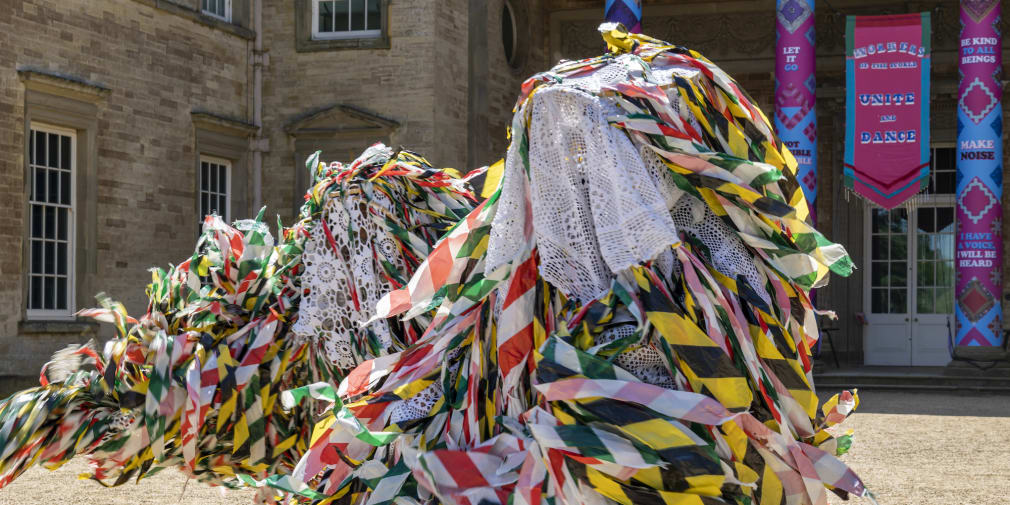Making Mischief
Project duration: December 2022 – January 2025
Funded by: National Lottery Heritage Fund (NLHF) £249,007
Making Mischief: the living heritage of folk costume in Britain looks through the lens of folk costume as a unifying form of identify and expression. Led by Centre for Fashion Curation at London College of Fashion, University of the Arts London and in partnership with the Museum of British Folklore (MoBF) and Compton Verney Art Gallery.
This project will explore, document and bring this heritage to life at 2 major immersive exhibitions. The result will be a multi-faceted re-interpretation of British folk custom that future generations can learn from.
Project Summary
Clothing is an essential part of everyone’s identity, and folk costume is an important representation of communities’ shared rituals and customs. ‘Making Mischief’ will celebrate and safeguard the folk dress heritage important to a wide range of communities, including refugee and immigrant folk cultures, as well as new and emerging folk cultures.
We will co-create with those actively seeking to preserve their at-risk folk heritage: Carnival (primarily Afro-Caribbean communities); Jack in the Green festival (who have embraced LGBTQIA* ‘Gay Bogies’) and (working class, east London) Pearlies.
The very nature of British folk custom as a local and ‘unrecognised’ form of heritage means it is: rarely recorded or preserved; folk dress is often made of perishable plants and flowers; and its performative nature relies on regular engagement to remain alive.
'Making Mischief' consists of 2 exhibitions accompanied by an ambitious public program of workshops, talks, new commissions, as well as an oral history and collecting programme. Using high profile exhibition spaces will contribute to the perception of folk heritage as a mainstream form of culture worthy of preservation and future investment.
Project aims
- ‘Making Mischief’ aims to document the colourful, community-based celebrations of Britain's folk heritage and bring it to life at 2 exhibitions.
- Challenge perceptions that British folk cultures are archaic, conservative and exclusively rural.
- Focus on folk as a collective form of creative expression that unites individuals and communities in time, place and (often) the natural world, with the potential to be subversive, political and mischievous.
- Highlight evolving practices such as the rise of all-female Morris groups and the inclusion of LGBTQ+ performers in customs like the Hastings Jack in the Green.
Exhibitions
London College of Fashion East Bank
The Making More Mischief exhibition at LCF East Bank (9 April - 22 June 2024) offers a fresh perspective on the pivotal role of costume in local and seasonal folk customs, with a distinct focus on London.
This exhibition presents captivating narratives, objects, and items ranging from the iconic Pearly Kings and Queens to the vibrant Notting Hill Carnival as well as never before-seen installations/soundscapes and workshops resulting from collaborations with Numbi Arts and Pxssy Palace.
An accompanying series of oral histories, captured by oral history trained volunteers, delves into the vibrant world of folk participants, costume makers and wearers reflecting the diverse tapestry of British folk customs and the individuals who bring them to life.
Compton Verney
The exhibition at Compton Verney (2023) traced the origins of folk costume in Britain across several centuries, using loans from the Museum of British Folklore, the English Folk Dance and Song Society (EFDSS), and the English Folk Costume Archive alongside works from Compton Verney’s collection. It further showcased how strong concerns for and connections with the environment and natural world are across these very different communities.
Impact
- As the embodiment of ‘make do and mend’ culture, we will use construction of folk dress to encourage visitors to increase their positive environmental impact. Fun, creative, activities will teach new skills for reducing textile waste in everyday clothing and inspire collective activism.
- A practical dyeing workshop in Compton Verney’s grounds teaching use of natural dyes available locally – limiting use of chemicals harmful to the environment and encouraging re-use of fabrics and clothing. LCF will host straw workshops to make a folk-inspired headpiece or token.
- Compton Verney and LCF will deliver workshops teaching people to use buttons to decorate and repair clothes.
- LCF will host interactive audio-guided walks on the historic button industry in East London, making connections to the local ‘Pearlies’, whose folk dress is famous for its ‘pearl’ buttons.
- We will create ‘button banks’ which will collect and recycle the unused buttons.
Project team
Simon Costin
Simon Costin is an internationally respected art director and set designer renowned for the conceptually ambitious nature of his editorial and catwalk designs. He is also a museum curator and the director of the Museum of Witchcraft and Magic and the founder and director of the Museum of British Folklore.
Mellany Robinson
Mellany has a long affiliation with folk - as a child in the seventies, her father's deep love of folklore and music made a vivid impression on her young mind. Her personal and work experience brings a unique perspective to the Museum of British Folklore and she is working with MoBF in the role of Project Manager.
As a project manager, Mellany is developing the temporary exhibition programme and the overall plans for a permanent Museum as well as coordinating elements of the Making Mischief project.
Amy de la Haye
Professor Amy de la Haye is a curator, writer and tutor as well as joint Director of the Research Centre for Fashion Curation at London College of Fashion, UAL.
Much of Amy's work is united by an emphasis upon interpreting items of fashion and dress, often imprinted with wear and occasionally completely perished, to tell stories about lives lived. She has worked as a curator in international museums (Museum at FIT, New York and Palazzo Morando, Milan), national museums (full-time fashion curator at the V&A 1991-1999), regional museums (Brighton Museum, freelance 2000 - 2017), as well as commercial contexts (Selfridges, Jaeger, Carnaby Street). Amy is also an exhibition reviewer on SHOWstudio.
- Read more on Amy's research profile




